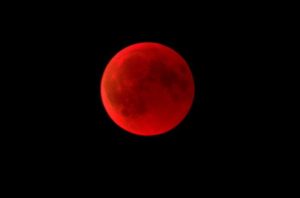

Strange Sounds – May 12, 2021
It’s almost time for another “Blood Moon” eclipse in North America—the first for over two years! “Blood Moon 2021,” a total lunar eclipse, will occur in the early hours of May 26, 2021 and be visible to some—but not all—of North America.
A total lunar eclipse, during which observers see a red Moon, can only occur at full Moon. The full Moon in May 2021 is called the “Flower Moon,” simply for the time of year it occurs in the northern hemisphere.
So why is the event being trailed as the “Super Flower Blood Moon 2021?”
Here are three things you need to know about 2021’s only total lunar eclipse.
1. It’s a ‘supermoon,’ the biggest and brightest full Moon of 2021
The “Super Flower Blood Moon 2021” is a “supermoon.”
It will be about 7% bigger than an average full Moon, but that’s not something you’re going to notice. What you will probably notice is that it will be about 15% brighter—the brightest, in fact, of 2021. That’s because it’s the closest full Moon to Earth of 2021.
The entire world can enjoy this special sight of a “supermoon.” All you have to do is look to the east around dusk to see a fabulous full moonrise.
2. It’s a ‘Blood Moon,’ 2021’s only total lunar eclipse
From 11:11-11:25 UTC the full Moon will turn a reddish color. You can find out if you can see it from where you are using this eclipse map.
A total lunar eclipse occurs when a full Moon enters Earth’s shadow in space. Of course, Earth is always casting a shadow into outer space opposite the Sun. It extends to around 870,000 miles/1.4 million km.
The Moon’s orbital path around Earth is roughly 5% inclined to the path of the Sun through our sky, so it rarely causes an eclipse of the Sun. So too lunar eclipses.
3. You’ve got a 50% chance of seeing it from where you are in North America
The entire night-side of Earth will witness the full Moon turn a reddish color during a brief 15-minute totality on May 26, 2021, but in many parts of the U.S the Moon will set just as the eclipse gets going.